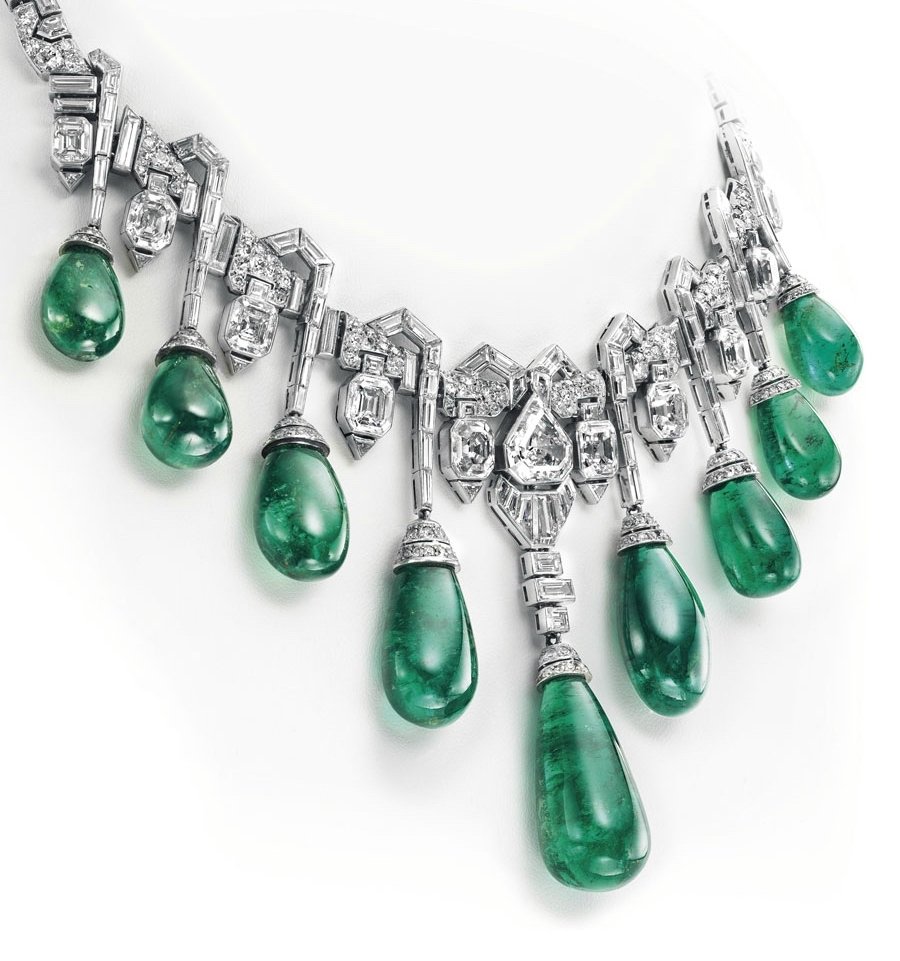A ROMANOV EMERALD RESURFACES AT AUCTION
One of the things I love the most is tracing the journeys of important gems. Having previously written about the famed emeralds owned by the Grand Duchess Vladimir of Russia, I was fascinated to hear that a single one of these stones had made an auction appearance earlier this year. The stone attracted attention not only because of its Imperial provenance, but also because it was arguably the finest emerald in the Grand Duchess’ collection.
Originally, the emerald was part of a parure, a wedding present from the Romanovs to Princess Marie of Mecklenburg-Schwerin, to celebrate her marriage to the uncle of Tsar Nicholas II, upon which she became Her Imperial Highness The Grand Duchess Vladimir Pavlovna. These stones, in my opinion, were probably the finest collection of emeralds ever owned by an individual, unrivalled in size, quality and colour match. The fullest extent of the Grand Duchess’ emerald collection can be seen in the famous photograph of her in historical Russian costume for a ball in 1903. The centre stone of the parure’s necklace (more of which later) was a hexagonal specimen weighing over 100 carats, and can clearly be seen on the headdress. The stone recently sold at auction was originally an emerald cut weighing 107.67 carats, set in diamonds and suspending an important drop emerald; this can also clearly be identified pinned at the front. The rest of her emerald jewellery, all containing stones of considerable size, is sewn all over her dress.
Upon her death in 1920, the emeralds were inherited by the Grand Duchess’ son, the Grand Duke Boris, the rest of the jewellery divided into colours and bequeathed thus to her other children. The first break up of the emeralds was effected by the Grand Duke, who sold the emerald necklace in about 1922 to Cartier; they were subsequently reset into a sleek Art Deco sautoir, bought by Edith McCormack Rockefeller. However, some of the stones must have been held back by the Grand Duke, who clearly only sold out of sheer necessity. The emerald set in the brooch sold by Christie’s was only acquired from the Grand Duke by Cartier in 1927; on expert gemmological advice the stone was recut from a 107.67 cut to an unrecognizable 75.63 pear shape. The pear shape was then sold to John D. Rockefeller Jr., brother of Edith and owner of the other stones. John D. Jr. must have known the Imperial provenance of the emerald he had bought and must have wanted to reunite it with the Imperial stones in his sister’s sautoir.The reunion was to be short lived; Edith McCormick died in 1932 and the necklace was sold and bought by the heiress Barbara Hutton, the transaction brokered once more by Cartier. At this point, the more of the stones must have been dispersed: the McCormick sautoir clearly contained nine stones; when Barbara Hutton had Cartier reset the emeralds into a tiara convertible into a necklace, there are only seven. There is speculation that she used the other stones in a ring and earrings, but on close inspection of photographs of these items it is impossible that the stones in these were recut octagon emeralds from the Vladimir necklace.
The stone... was originally an emerald cut weighing 107.67 carats.”
If we go back to the emeralds as they were given to the Grand Duchess, we can also see that suspended from the necklace are nine important cabochon drop shape stones. These stones do not feature in any of the McCormick/Hutton versions of the necklace- nor do they feature in any jewels created by Cartier in either the 20s or 30s. I have a hunch: in 1929, Van Cleef unveiled a spectacular diamond necklace in the Art Deco style suspending 9 cabochon briolette emeralds, remarkably similar in shape and size to the 9 in the original Vladimir necklace. I suspect that the Grand Duke had retained these stones, disposing of them only in 1927, the same time at which he sold the 100 carat emerald brooch. Should my hunch be correct, I have no idea why the stones would have ended up in the hands of rival jewellery houses. Speculatively, it would make it the second time Van Cleef handled emeralds from the same Romanov source, as they acquired Barbara Hutton’s tiara in the mid 1960s and sold the stones off piecemeal. The Art Deco necklace was bought in 1947 by Princess Faiza of Egypt and is now owned by a private collector.
The drop shape emerald had been bought from the Rockefellers by the Esmerian family, the same gemmologists who had advised on recutting the gem. The pear is set in an unremarkable contemporary diamond setting which I suspect will not survive, achieving an auction price of CHF4,335,000. Imagine if the stones had survived as a set.
The Art Deco necklace unveiled by Van Cleef and Arpels in 1929; I find the similarity of these emeralds to the drops in the original Vladimir necklace remarkable.





